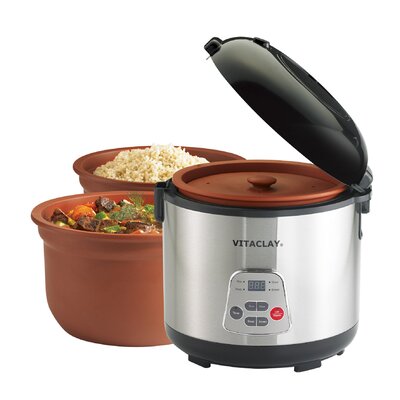I have been using my slow cooker non-stop lately. I have a Vitaclay, which has a clay bowl. It is a natural material that is also naturally non-stick, a lovely alternative to ones that contain teflon or lead. I have a small, 6 cup one which is great for one or two people. Generally if I make dinner for myself and fill the pot all the way, I have plenty left over for the next day as well. Neither my husband or I have set schedules and he has been very busy with grad school lately that we do not always eat dinner together or at the same time; so some nights I eat alone and some nights with him, but the slow cooker is perfect for either. I have been making a lot of dinners composed of just veggies and protein in it. Basically just throwing cut up veggies, any combination I have, and adding protein on top. It is great for a number of reasons. It is the ultimate lazy dinner, as it takes very little time to prepare and only uses up a couple of dishes. I have never been one for cutting veggies evenly or developing my knife skills at all, and you don't really have to with this method. For the most part, you can cut as haphazardly as you want, making sure tougher veggies are small enough to keep up with the non-tough ones. The combinations are endless and pretty risk-free, as the flavors blend together much more than they would if everything was cooked separate. I also love the texture of the prepared foods. The way mine have turned out so far (I am sure I could experiment more and keep the veggies a little less tender), the veggies and meats are very very soft. However, they are so much more flavorful than they would be otherwise because everything is contained in the pot, making it impossible for flavor to escape. All the liquid is contained in the pot as well, and I make sure to consume all of it together to retain all the nurtrients that would be lost with other cooking methods. However, the most important thing I have made so far with my slow-cooker is home-made chicken stock.
I could do a whole post on why you should make chicken-stock and why it is so good for you (maybe I will?), but I think for the most part it is a given. What most people might not know is the BIG problem with store bought chicken stock. They can contain added sugar, flavorings or MSG (natural flavor is an acceptable term for MSG also). They are also always pasteurized, which kills any heat sensitive vitamins. They also do not taste great and it is impossible to trace where the chicken came from that was used for it. There are of course some great recipes and "how to" guides for chicken stock from various sources, but mine is a little different because it is adapted for small spaces and single diners.
I use left-over chicken bones from dinners I make regularly. Since I tend to buy small cuts of chicken, like wings or thighs, these tend to be small but plentiful. Larger bones contain more nutrition, and using a whole carcass is ideal; but this way works well too, and I figure as long as I consume it regularly I am getting plenty of added nutrients to my overall diet. I usually freeze the bones as I go, in either glass or plastic, and make the stock when I have enough. When I am ready, I throw the bones in the slow-cooker pot. Than I add whatever veggies I want. I think carrots and celery are always good basics. Also, any non-sulfer veggie can be thrown in. The sulfur veggies, like broccoli, tend to have an overpowering flavor when used for stock. The great thing is that you can use veggies that are just past their prime, like some wilted kale that you do not think will saute up nice. Add some garlic cloves, no need to chop, and some course cut up onion if you want. Next, I add some spices of my choosing. Lots of herbs and some cayenne pepper, as we like things spicy around here. And don't forget to add a good amount of sea salt and some apple cider vinegar, just a small splash, to help draw the nutrients out of the bones. Add pure water to just under the lid. The first time I did this, I ended up having a less-flavorful stock because I added more water than bones, figuring my yield would be small; but after discovering I had much more stock than I thought I would, I ended up cutting the water significantly the next time.
Side note: Pleas forgive these horrible pictures! I am working on adding good pics to all my posts soon but for now I just wanted to have something to show so I used my cell phone camera...
I set the timer for 12 hours, which in the Vitaclay means using the "stew" setting and adding eight hours to the timer. It will stay in "warm" mode 12 hours after cooking so at most you have 24 hours to drain the liquid.
http://www.westonaprice.org/childrens-health/slow-cooker-rules
http://www.westonaprice.org/food-features/why-broth-is-beautiful
http://www.thenourishinggourmet.com/2011/09/bone-broth-take-frugal-to-a-new-level.html




No comments:
Post a Comment